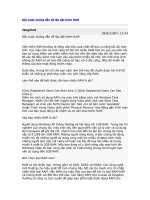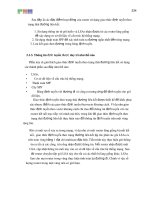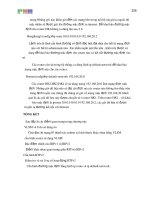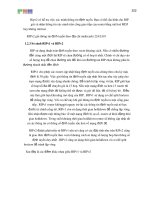KIỂM TRA cáp (cable testing) (MẠNG máy TÍNH cơ bản SLIDE)
Bạn đang xem bản rút gọn của tài liệu. Xem và tải ngay bản đầy đủ của tài liệu tại đây (757.25 KB, 48 trang )
Chương 4
KIỂM TRA CÁP (Cable testing)
OverView
• Networking media is literally and physically
the backbone of a network. Inferior quality of
network cabling results in network failures
and unreliable performance.
Computer Network
1
• Copper, optical fiber, and wireless
networking media all require testing to
determine the quality. These tests involve
certain electrical and mathematical concepts
and terms, such as signal, wave, frequency,
and noise. Understanding this vocabulary is
helpful when learning about networking,
cabling, and cable testing.
• The goal of the first lesson in this module is
to provide some basic definitions so that the
cable testing concepts presented in the
second lesson will be better understood.
Computer Network
2
• The second lesson of this module
describes the issues relating to the testing
of media used for physical layer
connectivity in local-area networks (LANs).
In order for the LAN to function properly,
the physical layer medium must meet the
industry standard specifications.
Computer Network
3
• Attenuation (signal deterioration) and noise
(signal interference) cause problems in
networks because the data is not
recognizable when it is received. Proper
attachment of cable connectors and proper
cable installation are important. If standards
are followed in these areas, attenuation and
noise levels are minimized.
Computer Network
4
4.1. Cơ sở nghiên cứu kiểm tra cáp dựa vào tần
số (Background for Studying Frequency-Based
Cable Testing)
4.1.1. Sóng (Wave)
• Networking
professionals
are
specifically
interested in voltage waves on copper media, light
waves in optical fiber, and alternating electric and
magnetic fields called electromagnetic waves. The
amplitude of an electrical signal still represents
height, but it is measured in volts instead of
meters. The period is the amount of time to
complete one cycle, measured in seconds. The
frequency is the number of complete cycles per
second, measured in Hertz.
Computer Network
5
4.1.2. Sóng sin và sóng vng (Sine waves and
square waves)
• Sine waves, or sinusoids, are graphs of
mathematical functions. Sine waves have certain
characteristics. Sine waves are periodic, which
means that they repeat the same pattern at regular
intervals. Sine waves are continuously varying,
which means that no two adjacent points on the
graph have the same value.
• Sine waves are graphical representations of many
natural occurrences that change regularly over
time. Since sine waves are continuously varying,
they are examples of analog waves.
Computer Network
6
Computer Network
7
• Square waves, like sine waves, are periodic.
However, square wave graphs do not
continuously vary with time. The wave holds
one value for some time, and then suddenly
changes to a different value. This value is
held for some time, and then quickly
changes back to the original value. Square
waves represent digital signals, or pulses.
Like all waves, square waves can be
described in terms of amplitude, period, and
frequency
Computer Network
8
Computer Network
9
4.1.3. Lũy thừa và logarith (Exponents and
logarithms)
• In networking, there are three important number
systems:
– Base 2 – binary
– Base 10 – decimal
– Base 16 – hexadecimal
• Exponent of the base of a number system also
refers to the value of each digit. The least
significant digit has a value of base0, or one. The
next digit has a value of base1. This is equal to 2
for binary numbers, 10 for decimal numbers, and
16 for hexadecimal numbers.
Computer Network
10
• Numbers with exponents are used to easily
represent very large or very small numbers.
It is much easier and less error-prone to
represent one billion numerically as 109 than
as 1000000000. Many calculations involved
in cable testing involve numbers that are
very large, so exponents are the preferred
format. Exponents can be explored in the
flash activity.
Computer Network
11
• One way to work with the very large and
very small numbers that occur in networking
is to transform the numbers according to the
rule, or mathematical function, known as the
logarithm. Logarithms are referenced to the
base of the number system being used. For
example, base 10 logarithms are often
abbreviated log. While the study of
logarithms is beyond the scope of this
course, the terminology is used commonly
in calculating decibels, a way of measuring
signals on copper, optical, and wireless
media.
Computer Network
12
4.1.4. Decibels
• The decibel (dB) is a measurement unit
important in describing networking signals.
The decibel is related to the exponents and
logarithms described in prior sections. There
are two formulas for calculating decibels:
dB = 10 log10 (Pfinal / Pref)
dB = 20 log10 (Vfinal / Vreference)
Computer Network
13
• The variables represent the following values:
– dB measures the loss or gain of the power of a
wave. Decibels are usually negative numbers
representing a loss in power as the wave
travels, but can also be positive values
representing a gain in power if the signal is
amplified
– log10 implies that the number in parenthesis will
be transformed using the base 10 logarithm rule
– Pfinal is the delivered power measured in Watts
– Pref is the original power measured in Watts
– Vfinal is the delivered voltage measured in Volts
– Vreference is the original voltage measured in
Volts
Computer Network
14
• The first formula describes decibels in
terms of power (P), and the second in
terms of voltage (V). Typically, light waves
on optical fiber and radio waves in the air
are measured using the power formula.
Electromagnetic waves on copper cables
are measured using the voltage formula.
These formulas have several things in
common.
Computer Network
15
4.1.5. Tạp âm trong miền tần số và miền
thời gian (Noise in time and frequency)
• Noise is an important concept in
communications systems, including LANS.
While noise usually refers to undesirable
sounds, noise related to communications
refers to undesirable signals. Noise can
originate from natural and technological
sources, and is added to the data signals in
communications systems.
Computer Network
16
• All communications systems have some
amount of noise. Even though noise cannot
be eliminated, its effects can be minimized if
the sources of the noise are understood.
There are many possible sources of noise:
– Nearby cables which carry data signals
– Radio frequency interference (RFI), which
is noise from other signals being
transmitted nearby
Computer Network
17
– Electromagnetic interference (EMI),
which is noise from nearby sources
such as motors and lights
– Laser noise at the transmitter or receiver
of an optical signal
Computer Network
18
• Noise that affects all transmission frequencies
equally is called white noise. Noise that only affects
small ranges of frequencies is called narrowband
interference. When detected on a radio receiver,
white noise would interfere with all radio stations.
Narrowband interference would affect only a few
stations whose frequencies are close together.
When detected on a LAN, white noise would affect
all data transmissions, but narrowband interference
might disrupt only certain signals. If the band of
frequencies
affected
by
the
narrowband
interference included all frequencies transmitted on
the LAN, then the performance of the entire LAN
would be compromised
Computer Network
19
Computer Network
20
4.1.6. Băng thơng (Bandwidth)
• Bandwidth is an extremely important
concept in communications systems. Two
ways of considering bandwidth that are
important for the study of LANs are analog
bandwidth and digital bandwidth.
Computer Network
21
• Analog bandwidth typically refers to the
frequency range of an analog electronic
system. Analog bandwidth could be used to
describe
the
range
of
frequencies
transmitted by a radio station or an
electronic
amplifier.
The
units
of
measurement for analog bandwidth is Hertz,
the same as the unit of frequency. Examples
of analog bandwidth values are 3 kHz for
telephony, 20 kHz for audible signals, 5 kHz
for AM radio stations, and 200 MHz for FM
radio stations.
Computer Network
22
• Digital bandwidth measures how much
information can flow from one place to
another in a given amount of time. The
fundamental unit of measurement for digital
bandwidth is bits per second (bps). Since
LANs are capable of speeds of millions of
bits per second, measurement is expressed
in kilobits per second (Kbps) or megabits per
second (Mbps). Physical media, current
technologies, and the laws of physics limit
bandwidth.
Computer Network
23
• During cable testing, analog bandwidth is
used to determine the digital bandwidth of a
copper cable. Analog frequencies are
transmitted from one end and received on
the opposite end. The two signals are then
compared, and the amount of attenuation of
the signal is calculated. In general, media
that will support higher analog bandwidths
without high degrees of attenuation will also
support higher digital bandwidths
Computer Network
24
4.2. Tín hiệu và tạp âm (Signals and Noise)
4.2.1. Phát tín hiệu qua dây đồng và cáp quang
(Signaling over copper and fiber optic cabling)
• On copper cable, data signals are represented by
voltage levels that represent binary ones and
zeros. The voltage levels are measured with
respect to a reference level of zero volts at both
the transmitter and the receiver. This reference
level is called the signal ground. It is important that
both transmitting and receiving devices refer to the
same zero volt reference point. When they do,
they are said to be properly grounded.
Computer Network
25









